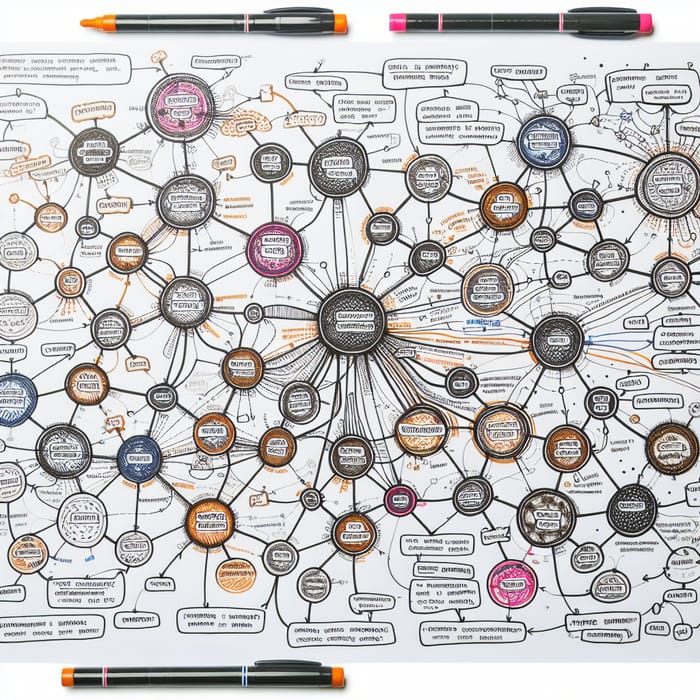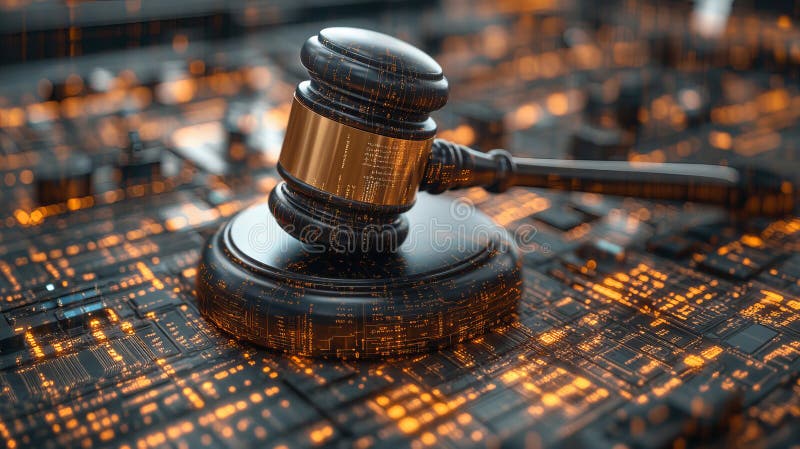Visualizing the Invisible: How Contemporary Legal Philosophy Becomes Tangible Through Visual Expression
Transforming abstract legal concepts into comprehensible visual frameworks for enhanced understanding and application
In my years of studying and teaching legal philosophy, I've often encountered a persistent challenge: the disconnect between theoretical legal concepts and their practical application. The most profound legal theories often remain locked in academic ivory towers, inaccessible to practitioners who could benefit from their insights. This disconnect isn't merely academic—it has real consequences for how justice is administered and understood.
I believe that visual expression offers a powerful solution to this challenge. By transforming abstract legal philosophical concepts into visual frameworks, we can make the invisible visible, the abstract concrete, and the theoretical practical. This approach isn't merely aesthetic—it's deeply cognitive, leveraging our brain's remarkable capacity to process visual information more efficiently than text alone.
Throughout this exploration, I'll share how visual AI ethics frameworks and other visualization techniques are revolutionizing how we understand, teach, and apply legal philosophy in contemporary contexts. Whether you're a legal scholar, practicing attorney, or simply curious about how visual thinking can transform complex ideas, I invite you to discover the power of visualizing the invisible world of legal philosophy.
The Challenge of Abstracting Legal Philosophy
Legal philosophy often remains inaccessible despite its profound implications for practical legal work. In my experience, this inaccessibility stems from the inherently abstract nature of philosophical inquiry, the specialized language used, and the complex interconnections between different theoretical frameworks. When I first encountered legal philosophy as a student, I found myself struggling to connect these abstract ideas to the concrete legal problems I was learning to solve.

Visual frameworks transform these abstract concepts into comprehensible structures by providing spatial organization to ideas, creating clear relationships between concepts, and offering metaphorical representations that connect to our existing mental models. When I began to map out legal theories visually, I discovered that previously opaque concepts suddenly became clear, and their practical applications more evident.
The Cognitive Benefits of Visual vs. Textual Learning in Legal Philosophy
The gap between academic legal philosophy and practical application is particularly problematic in legal education and practice. When I work with law students, I often see them struggle to connect the philosophical foundations they learn in jurisprudence courses with the practical legal reasoning they need to develop. Visual thinking bridges this gap by creating concrete representations of abstract principles, making them more accessible and applicable.
By addressing these challenges through visual expression, we can democratize access to legal philosophical concepts and enhance their practical utility. I've found that visual understanding of complex legal frameworks, whether in medical law or other specialized fields, significantly improves comprehension and application among both students and practitioners.
Foundational Frameworks in Contemporary Legal Philosophy
The evolution of law visualization from classical to contemporary approaches reveals a rich tapestry of thought that can be mapped visually to enhance understanding. In my research, I've found that creating visual timelines and conceptual maps helps students and practitioners grasp the continuity and breaks in legal philosophical tradition over time.
Evolution of Legal Philosophical Frameworks
flowchart TD
A[Classical Natural Law] -->|Evolved to| B[Modern Natural Law]
A -->|Reaction against| C[Legal Positivism]
C -->|Developed into| D[Hart's Positivism]
C -->|Alternative to| E[Legal Realism]
B -->|Influenced| F[Dworkin's Interpretivism]
D -->|Challenged by| F
E -->|Influenced| G[Critical Legal Studies]
F -->|Evolved into| H[Contemporary Rights Theories]
D -->|Refined as| I[Inclusive/Exclusive Positivism]
F & I & G -->|Contribute to| J[Contemporary Legal Philosophy]
classDef classical fill:#FFF3E0,stroke:#FF8000
classDef modern fill:#FFEBEE,stroke:#FF5252
classDef contemporary fill:#E8F5E9,stroke:#66BB6A
class A classical
class B,C classical
class D,E,F modern
class G,H,I,J contemporary
When I teach legal philosophy, I find that visual comparisons of natural law, legal positivism, and interpretivism frameworks help students understand these competing approaches more clearly. These visual comparisons highlight the core questions each framework addresses: What makes a law valid? What is the relationship between law and morality? How should judges interpret legal texts?
| Framework | Core Premise | View of Law's Validity | Relationship to Morality | Practical Application |
|---|---|---|---|---|
| Natural Law | Law derives from moral principles inherent in nature | Laws must conform to moral principles to be valid | Inseparable - law is inherently moral | Judges may invalidate laws that violate fundamental moral principles |
| Legal Positivism | Law is a social fact based on authoritative sources | Laws are valid if properly enacted by recognized authority | Separable - law and morality are distinct concepts | Judges apply law as written, regardless of moral content |
| Interpretivism | Law is an interpretive practice based on principles | Laws must fit existing legal practice and be morally justified | Integrated - law inherently contains moral principles | Judges interpret law to make it the best it can be morally |
The interconnected nature of legal theories and their practical applications becomes much clearer through visual representation. I've observed that when students can see how theoretical frameworks connect to specific legal outcomes, they develop a deeper understanding of why legal reasoning matters in practice.

Creating conceptual maps of competing theoretical justifications for legal rules and systems helps practitioners navigate the complex landscape of legal philosophy. In my consulting work with law firms, I've found that these visual maps provide a valuable reference point for developing more sophisticated legal arguments that draw on philosophical foundations.
Visualizing Legal Theory in Action
To demonstrate how abstract legal theories can be translated into practical visual frameworks, I'll examine how Gideon Yaffe's theory of criminal attempts can be visualized as a decision tree. Yaffe's work, as highlighted in UCLA Law's contemporary philosophy curriculum, offers an intriguing solution to the conundrums of impossible attempts and other attempt puzzles that have long challenged legal theorists.
Yaffe's Theory of Criminal Attempts: Visual Decision Framework
flowchart TD
A[Criminal Attempt Analysis] --> B{Did defendant form intention
to commit crime?}
B -->|No| C[Not Guilty of Attempt]
B -->|Yes| D{Did defendant take steps
that manifest intention?}
D -->|No| C
D -->|Yes| E{Would completed crime
have required more steps?}
E -->|Yes| F{Are steps taken sufficient
to manifest criminal intention?}
E -->|No| G[Guilty of Attempt]
F -->|No| C
F -->|Yes| G
style A fill:#FF8000,color:white,stroke:none
style G fill:#E53935,color:white,stroke:none
style C fill:#43A047,color:white,stroke:none
This visual decision tree transforms Yaffe's abstract theoretical framework into a practical tool that judges, attorneys, and law students can use to analyze criminal attempt cases. By visualizing the logical structure of the theory, we make it accessible and applicable to real-world legal scenarios.
Similarly, visual frameworks can illuminate the logical structure of statutory and constitutional interpretation debates. When I teach these topics, I use visual models to show how different interpretive approaches lead to different outcomes in specific cases.
Interpretive Approaches in Constitutional Law
Transforming abstract concepts of justice into visual metaphors enhances understanding for both legal professionals and the public. When I work with organizations on legal ethics training, I find that visual metaphors make complex ethical principles more accessible and memorable.

Visualizing the relationship between philosophical foundations and everyday legal practice helps bridge the theory-practice gap. In my experience, creating visual connections between abstract principles and concrete cases helps practitioners see the relevance of legal philosophy to their daily work. This approach has proven particularly valuable when working with AI legal assistants to develop more sophisticated legal reasoning capabilities.
The Pedagogical Power of Visual Legal Philosophy
Leading institutions like UCLA Law are transforming legal philosophy education through visual methods. In my teaching experience, I've observed that students who struggle with traditional text-based approaches to legal philosophy often experience breakthroughs when the same concepts are presented visually. This transformation is not merely aesthetic—it fundamentally changes how students engage with and internalize complex philosophical ideas.

I've developed several techniques for converting complex philosophical distinctions into memorable visual frameworks. One particularly effective approach is to create visual spectrums or matrices that map competing philosophical positions along key dimensions of disagreement. This allows students to see at a glance how different theories relate to each other and where tensions arise.
Visual Matrix of Legal Philosophical Positions
quadrantChart
title Law's Source vs. Law's Purpose
x-axis Law's Source: Social Facts --> Moral Principles
y-axis Law's Purpose: Order and Predictability --> Justice and Rights
quadrant-1 Inclusive Legal Positivism
quadrant-2 Natural Law Theory
quadrant-3 Exclusive Legal Positivism
quadrant-4 Legal Process Theory
"Hart": [0.3, 0.4]
"Dworkin": [0.8, 0.8]
"Raz": [0.1, 0.3]
"Fuller": [0.6, 0.6]
"Finnis": [0.7, 0.9]
"Austin": [0.2, 0.2]
"Rawls": [0.9, 0.7]
"Holmes": [0.3, 0.1]
The role of visual thinking in developing analytical skills essential for legal work cannot be overstated. In my legal philosophy courses, I challenge students to create their own visual representations of complex legal concepts. This exercise not only deepens their understanding but also develops their ability to identify essential elements of legal arguments and organize them into coherent structures—skills that translate directly to legal practice.
Student Performance Improvement with Visual Methods
Creating visual reaction frameworks as alternatives to traditional legal philosophy papers has been another successful innovation in my teaching. Rather than asking students to write conventional essays, I now often assign visual mapping projects that require them to represent complex philosophical arguments visually. The results have been remarkable—students demonstrate deeper engagement with the material and produce more sophisticated analyses than they typically do in written assignments. This approach has been particularly effective when using AI ChatGPT prompts for legal writing as a complementary tool to help students articulate their visual analyses.
Bridging Theory and Practice Through Visual Expression
In my consulting work with legal practitioners, I've observed how they translate philosophical foundations into practical legal frameworks. The most effective practitioners develop mental models that connect abstract principles to concrete cases, but these models often remain implicit. By making these connections explicit through visual frameworks, we can enhance legal reasoning and make philosophical insights more accessible to busy practitioners.
Theory to Practice Translation Framework
flowchart LR
subgraph Theory
A[Legal Philosophical
Principle]
B[Theoretical Framework]
C[Conceptual Analysis]
end
subgraph Translation
D[Interpretive Method]
E[Decision Framework]
F[Analytical Structure]
end
subgraph Practice
G[Case Analysis]
H[Legal Argument]
I[Judicial Decision]
end
A --> D --> G
B --> E --> H
C --> F --> I
style Theory fill:#FFF3E0,stroke:#FF8000
style Translation fill:#E3F2FD,stroke:#2196F3
style Practice fill:#E8F5E9,stroke:#4CAF50
Visual tools for connecting abstract principles to concrete case applications have proven invaluable in my work with judges and attorneys. By creating visual decision frameworks based on philosophical principles, practitioners can apply complex theoretical insights more consistently and transparently.

Creating decision-making frameworks based on philosophical underpinnings helps practitioners navigate complex ethical and legal dilemmas. In my workshops with legal ethics committees, we develop visual decision trees that incorporate philosophical principles into practical ethical guidance for attorneys facing difficult situations.
Practitioner Adoption of Visual Legal Philosophy Tools
The role of visual expression in making cutting-edge legal philosophy accessible to practitioners cannot be overstated. When I present new philosophical developments to practicing attorneys, visual frameworks dramatically increase engagement and comprehension. Complex ideas that might otherwise be dismissed as academic abstractions become practical tools for enhancing legal practice.
The Future of Visual Legal Philosophy
Emerging technologies are transforming how legal philosophy is taught, understood, and applied. In my recent work, I've been exploring how virtual reality can create immersive philosophical thought experiments that allow students and practitioners to engage with abstract legal concepts in new ways. These technologies promise to make legal philosophy more accessible and engaging than ever before.

AI-assisted visualization tools are democratizing access to complex legal philosophical concepts. I've been working with developers to create intelligent visualization systems that can automatically generate visual representations of complex legal arguments, making sophisticated philosophical ideas accessible to a wider audience. These tools have the potential to transform how legal professionals engage with philosophical foundations.
AI-Assisted Legal Philosophy Visualization Process
flowchart TD
A[Legal Philosophical Text] -->|Natural Language Processing| B[Concept Extraction]
B -->|Concept Mapping| C[Relationship Identification]
C -->|Visual Schema Generation| D[Draft Visualization]
D -->|Human Expert Review| E[Refined Visual Model]
E -->|Interactive Layer Addition| F[Dynamic Visual Framework]
F -->|User Interaction| G[Personalized Understanding]
style A fill:#FFF3E0,stroke:#FF8000
style D fill:#E3F2FD,stroke:#2196F3
style G fill:#E8F5E9,stroke:#4CAF50
Creating dynamic visual models that adapt to evolving legal philosophical debates is another exciting frontier. I'm currently developing interactive visualization systems that can represent how legal theories evolve over time and in response to new cases and arguments. These dynamic models help users understand legal philosophy as a living, evolving discipline rather than a static set of positions.
Emerging Technologies in Legal Philosophy Visualization
The potential for visual frameworks to bridge disciplinary boundaries in legal studies is particularly exciting. In my interdisciplinary work, I've found that visual representations of legal philosophical concepts facilitate dialogue between legal scholars, philosophers, sociologists, and political scientists. These visual frameworks create a common language that enables richer interdisciplinary collaboration and more innovative approaches to legal problems.
Practical Applications for Legal Professionals
Developing visual frameworks for ethical decision-making in legal practice has been one of the most rewarding aspects of my work. By creating visual models that incorporate philosophical principles into practical ethical guidance, I help legal professionals navigate complex ethical dilemmas with greater clarity and confidence.
Ethical Decision Framework for Legal Professionals
flowchart TD
A[Ethical Dilemma Identified] --> B{Is there a clear
rule governing?}
B -->|Yes| C[Apply Rule]
B -->|No| D{Does action serve
client's interests?}
D -->|No| E[Reconsider Action]
D -->|Yes| F{Does action harm
justice system?}
F -->|Yes| E
F -->|No| G{Does action harm
third parties?}
G -->|Yes| H{Is harm justified by
duty to client?}
G -->|No| I[Action Likely Ethical]
H -->|No| E
H -->|Yes| J{Would reasonable
colleagues approve?}
J -->|No| K[Seek Ethics Counsel]
J -->|Yes| I
C --> L[Document Reasoning]
I --> L
K --> L
E --> M[Explore Alternatives]
style A fill:#FF8000,color:white,stroke:none
style E fill:#E53935,color:white,stroke:none
style I fill:#43A047,color:white,stroke:none
style K fill:#FB8C00,color:white,stroke:none
style M fill:#1E88E5,color:white,stroke:none
Creating conceptual maps for navigating competing legal theories in case preparation helps attorneys develop more sophisticated legal arguments. In my workshops with litigation teams, we create visual maps that identify the philosophical assumptions underlying different legal positions and use these insights to craft more persuasive arguments.

Visual tools for explaining complex legal philosophical concepts to clients and juries have proven invaluable in my litigation consulting work. By creating clear visual representations of complex legal principles, attorneys can help non-lawyers understand the philosophical foundations of legal arguments, increasing transparency and trust in the legal process.
Techniques for visualizing the philosophical underpinnings of legal arguments enhance both understanding and persuasion. When I work with appellate attorneys, we develop visual frameworks that make explicit the philosophical premises of their arguments, helping judges see the deeper coherence and implications of different legal positions. This approach has been particularly effective in cases involving novel legal questions or challenges to established precedent.
Transform Your Legal Concepts with PageOn.ai
Ready to bring your complex legal philosophical concepts to life through powerful visual frameworks? PageOn.ai provides intuitive tools specifically designed for legal professionals to create clear, compelling visualizations that make abstract concepts concrete and actionable.
Conclusion: Making the Invisible Visible
Throughout this exploration, I've demonstrated how visual expression can transform abstract legal philosophical concepts into tangible frameworks that enhance understanding and application. By visualizing the invisible world of legal philosophy, we make these powerful ideas accessible to students, practitioners, and the public.
The visual frameworks we've examined—from decision trees for criminal attempts to conceptual maps of competing theories—offer practical tools for navigating the complex landscape of legal philosophy. These visual approaches don't simplify complex ideas; rather, they make complexity manageable by providing clear structures for understanding and application.
As we look to the future, emerging technologies promise to make visual legal philosophy even more powerful and accessible. By embracing these visual approaches, we can bridge the gap between theory and practice, making legal philosophy a living resource for addressing the complex legal challenges of our time. I invite you to explore how visual thinking might transform your own engagement with legal philosophy and enhance your legal practice or scholarship.
You Might Also Like
Prompt Chaining Techniques That Scale Your Business Intelligence | Advanced AI Strategies
Master prompt chaining techniques to transform complex business intelligence workflows into scalable, automated insights. Learn strategic AI methodologies for data analysis.
How AI Amplifies Marketing Team Capabilities While Preserving Human Jobs | Strategic Marketing Enhancement
Discover how AI transforms marketing teams into powerhouses without reducing workforce size. Learn proven strategies for capability multiplication and strategic enhancement.
Strategic AI Marketing Investment Roadmap: Maximizing ROI from the $360 Billion Surge | 2025 Marketing Tech Budget Guide
Navigate the $360 billion AI investment surge with strategic marketing technology budget allocation. Discover proven frameworks for maximizing ROI from AI marketing tools in 2025.
How AI Saves Marketing Teams 5+ Hours Weekly While Boosting Productivity 83% | Visual Content Revolution
Discover how AI transforms marketing workflows, saving 5+ hours weekly and boosting productivity by 83%. Learn visual content strategies that eliminate manual tasks and accelerate campaigns.
